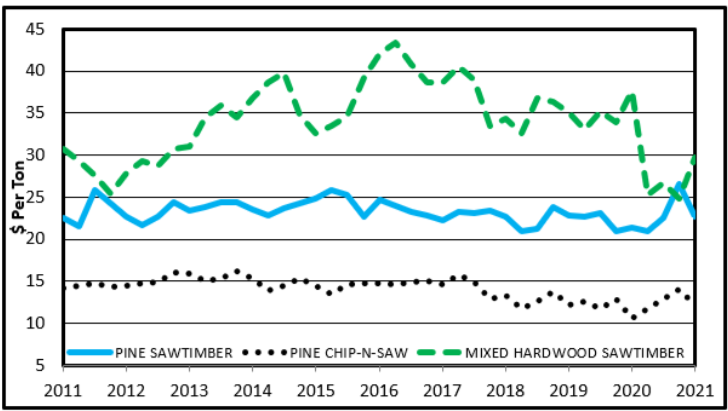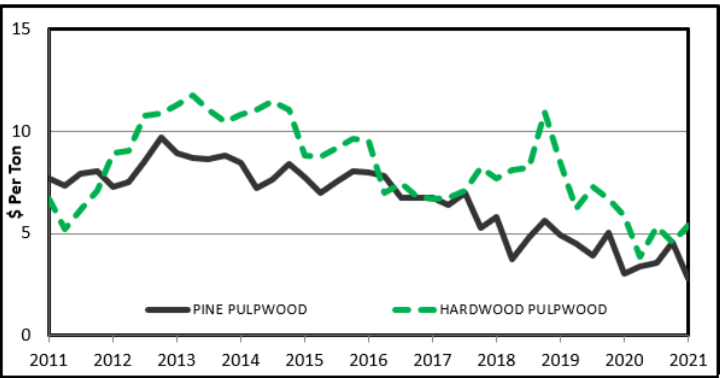Volume 10, Issue 3, August 2021
From the Coordinator's Desk
Brady Self, Extension Forestry Specialist
Fall is just around the corner and we are starting to see the normal increase in end-of-growing season forest management activities. Site preparation treatments are going out, seedling orders have been made. Planting contracts are being signed, logging operations are in full swing, and forest landowners are starting to prepare for fall and hunting season. In spite of difficulties associated with the last two years, our forest industry is still strong and continues to operate.
As we move into fall and winter, we would like to remind you that many of the County Forestry Associations are meeting again and will gladly welcome your attendance at a variety of functions. In addition, please continue to look to our Mississippi State University Extension Forestry Facebook and Twitter accounts for programming updates and new publications.
Mississippi Timber Price Report Importance and How to Contribute
Marcus Measells, Senior Extension Associate
The Timber Price Report provides regional and statewide stumpage prices for common forest products. Many landowners refer to it when deciding to market and harvest timber. However, it should only be used as a guide to monitor timber market trends. The average price should not be applied as fair market value for a specific timber sale because many variables influence actual prices. We always recommend working with a qualified consulting forester with experience in your region to conduct timber harvests. They have the best knowledge on local timber markets.
We have Timber Price Reports dating back to 1957 available here. The reporting process has changed numerous times.
For many years, we used Forest2Market and TimberMart-South, both subscription- based services. These companies provide more detailed data for their customers. However, we were only allowed to report statewide averages. Unfortunately, many foresters and landowners indicated the reports were not useful since we only reported statewide averages. Statewide averages do not reflect the true nature of how timber prices vary based on many variables (e.g., quality, distance to mill), making use of a statewide average less reliable than having prices available on a regional basis. Many landowners base timber sale decisions on the Timber Price Report data and could be missing opportunities to have timber sold when only using statewide averages.
To better serve forestry clientele, starting in January of 2018, we began collecting data across the state from forest product companies, logging contractors, consulting foresters, landowners, and other natural resource professionals. We divided the state into four regions and reported low, average, and high prices by region as well as statewide to provide a better picture of local market conditions. All data is kept confidential. Timber prices may be reported at any time during a quarter via the on-line reporting system, phone, or email. If you are interested in reporting timber sales, please contact me at 662-325-3550 or mkm2@msstate.edu. As always, the more timber sales reported, the better representation we have of timber prices. We encourage everyone to report timber sales when possible.
You can report your timber sales by calling us at 662-325-3550 or emailing mkm2@msstate.edu. Access to the online reporting system is also available by request.
Mississippi Timber Price Report - 2nd Quarter 2021
Marc Measells, Senior Extension Associate
The Mississippi Timber Price Report provides a picture of timber market activity across the state showing regional and statewide stumpage prices for common forest products. This report should only be used as a guide to help individuals monitor timber market trends. The average price should not be applied as fair market value for a specific timber sale because many variables influence actual prices individuals landowners receive. This report and previous historical timber prices are available by contacting your local county Extension office or here.
2nd Quarter 2021 Stumpage Prices/Ton (Source: MSU Extension)
NOTE: Prices vary widely across the state; average prices presented here may not reflect your local market.
- Pine Poles - $36.11
- Pine Sawtimber - $22.40
- Pine Chip N Saw - $12.11
- Pine Pulpwood - $2.81
- Oak Sawtimber - $44.32
- Mixed Hardwood Sawtimber- $29.72
- Crossties - $24.83
- Hardwood Pulpwood - $5.37
Price Trends:
Areas of Mississippi had above normal rainfall in April and June while May was relatively dry. Prices typically increase during wetter weather conditions. Landowners with land that could be harvested during wet weather benefited. Figures reflect 10- year statewide average price trends.
Compared to 1st quarter, statewide average prices changed (-38.5% to 19.8%) during the 2nd quarter with pine products declining and hardwood products increasing. Prices varied across regions. Prices for dimensional lumber peaked in May and have steadily declined. However, our abundant oversupply of standing timber continues to be the main contributor to depressed stumpage prices. The good news, mills are making progress on announced expansions and new mill construction. Many will begin production later this year and into next year. This added production capacity will benefit many landowners within the procurement radius of those mills.
Housing starts peaked in December 2020 and have fluctuated since and new housing permits have declined because of record lumber prices. The unemployment rate, although still high, has continued declining. As unemployment rates and the overall economy continue to improve, timber markets should recover. Most economic forecasters expect the recovery to continue throughout 2021. Prices during the 3rd quarter are expected to decline as we move into drier months. Keep in mind, we still face an enormous overabundant supply of standing timber which will restrain stumpage prices.
*Timber-Mart South (TMS), Inc. has more detailed data available by subscription that contains values for other timber products not included in this report. TMS is compiled and produced at the Center for forest Business, Warnell School of Forest Resources, University of Georgia, under contract with the Frank W. Norris Foundation, a non-profit corporation serving the forest products industry. See http://WWW.TMARTSOUTH.COM for information on subscriptions.


*Prices from 2011-2017 are from TimberMart-South. 2018-current prices are from Mississippi State University Extension.
Teacher's Conservation Workshop
Butch Bailey, Extension Associate
Much has been written about “Nature Deficit Disorder” and the repercussions to a society when young people lose connections with the outdoors. One way MSU Extension Forestry works to reestablish that connection is by getting teachers outdoors, learning about nature, and equipping them with information and tools to help inspire a passion for nature in their students. Each year MSU Extension Forestry partners with the Mississippi Forestry Association to conduct a series of multi-day workshops for teachers that do exactly this, while also offering 2.5-5.0 Continuing Education Credits for participating teachers. We call these our Teacher’s Conservation Workshops (TCW).
These workshops have been offered to Mississippi educators each summer for the last 60 years. During that time, we estimate that over 115 workshops have been conducted, and over 2,250 individual teachers have participated. Teachers are given guided tours of Mississippi’s forests and forest industries by dozens of natural resources professionals during these workshops. The workshops are built around the simple idea of giving teachers an in-depth crash-course in all aspects of forestry, conservation, and most importantly, equipping them with hands-on tools to get that information into their classrooms.
Each workshop begins with classroom lessons on forest ecology, the history of forestry and logging, and how our modern forest industry approaches sustainability. The week includes industry tours of sawmills, veneer mills, pulp mills, and other forest product manufacturing facilities. But the week isn’t spent focused solely on industry. Teachers are also taken on tours of our national forests, state parks, small private landowner tree farms, and other scenic locations.
In addition to the general information gained, they also participate in Project Learning Tree (PLT), a professionally developed curriculum that includes dozens of practical lesson-plans that give teachers the tools to “bring the outdoors into the classroom.” We know from teachers who participated in TCW in the past that PLT is a valuable tool that really makes a difference in the lives of Mississippi school children.
If you know of a teacher that might be interested in earning CEUs by learning about our state’s natural resources, be on the lookout for next year’s Teacher’s Conservation Workshops. Your local County Extension Office will have the details.
Delta Hardwood Notes: Species/Site Relationships When Planting Hardwoods
Brady Self, Extension Forestry Specialist
Landowners sometimes find themselves trying to determine the cause of hardwood planting failures that are seemingly without cause. Quality seedlings were planted correctly, without an unreasonable passage of time between lifting and planting, weather conditions have been conducive to seedling survival, no pest problems have been detected, and yet seedling mortality is high. Often the unconsidered factor is that of consideration of species/site relationships.
Our most heavily planted species in forest management, loblolly pine, can thrive when grown on a very wide range of sites and soil conditions. However, hardwood species are different. Selection of appropriate hardwood species for planting can be difficult due to the large number of species available and their varying needs for survival and growth. In many cases, the needs of different species may only be met by a combination of factors that exist only under different site and soil conditions.
To manage hardwoods well, you should understand the nutritional and moisture needs of your species of choice and the types of soil that best meet these needs. In general, the most desirable species will survive and grow well only on a narrow range of sites and conditions. Correctly matching species to site will result in a stand capable of surviving and growing well over an extended period of time. Careful site analysis of your planting area is necessary prior to planting. For more information on species/site relationships, please read Mississippi State University Extension Publication 2004 “Bottomland Hardwood Management: Species/Site Relationships.”
Upcoming Events Fall 2021
Mid-South Forestry Equipment Show
September 17-18, 2021; Starkville, MS
Pre-Registration (closes Sept. 6): $20, Day-of registration: $25
The Mid-South Forestry Equipment Show is the Deep South’s premier forestry show. It is the oldest outdoor, live logging demonstration in the nation where equipment manufacturers are allowed to operate their equipment in actual field conditions. The show has been in operation for over 35 years providing a grass-roots technology transfer between loggers, landowners, foresters, and equipment manufacturers. Two-day attendance for the past six show events has averaged 6,000 participants.
Register at: http://www.midsouthforestry.org
Autumn Tree ID Seminar
October 2, 2021; North MS Fish Hatchery, Yalobusha County, MS
Admission: $2.50 for adults, $2.00 for ages 3-17 and adults 60+
For more information, please contact the Visitor Education Center at (662) 563-8068.
MFA Annual Meeting
October 13-15, 2021; Biloxi, MS
Online Registration is Open! (closes Sept. 28)
Members are encouraged to take advantage of the early bird registration discount offered until August 25th. After September 28th, registrations must be made on-site and a $25 late fee will be assessed.
Register at: https://www.msforestry.net
Primary Business Address
Mississippi State University
Forestry Extension
P.O. Box 9681
775 Stone Blvd
Mississippi State, MS 39762
Contact: Ms. Laura Terry
let181@msstate.edu
662-325-2946
Fax: 662-325-0027
Regional Personnel:
NE District: Dr. John Kushla
662-566-8013, or John.Kushla@msstate.edu
NW District: Dr. Brady Self
662-226-6000, or brady.self@msstate.edu
SW District: Dr. Curtis VanderSchaaf
SE District: Mr. Butch Bailey
601-794-0671, or asb1@msstate.edu
SE District: Dr. Shaun Tanger
228-546-1014, or smt489@msstate.edu
Campus Personnel:
Professional Logging Manager, Tree Farm and SFI: Dr. John Auel
662-325-7948, or jba9@msstate.edu
Timber Prices, Economics, Certification: Mr. Marc Measells
662-325-3550, or mkm2@msstate.edu
Media: Ms. Laura Terry
662-325-2946, or let181@msstate.edu





